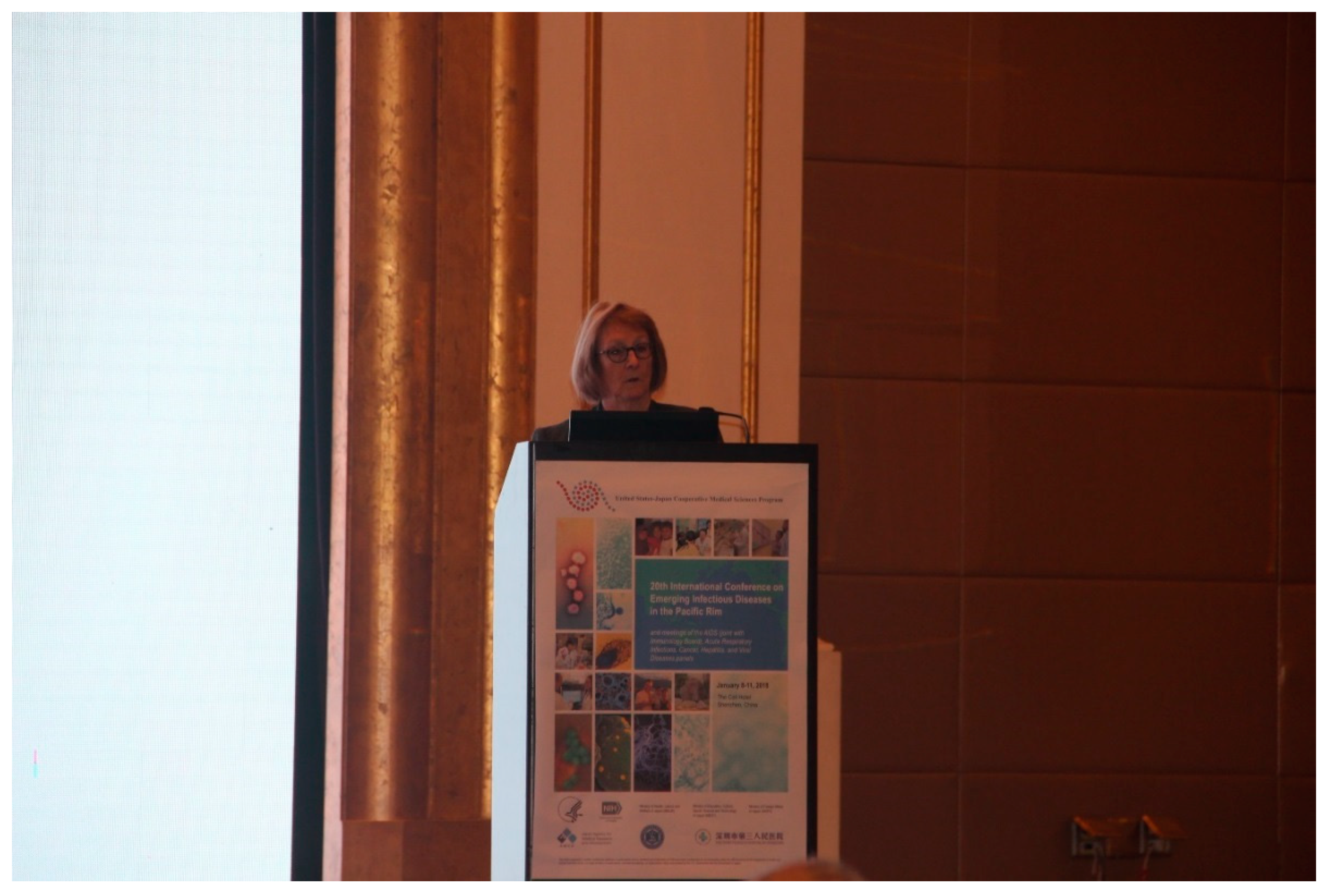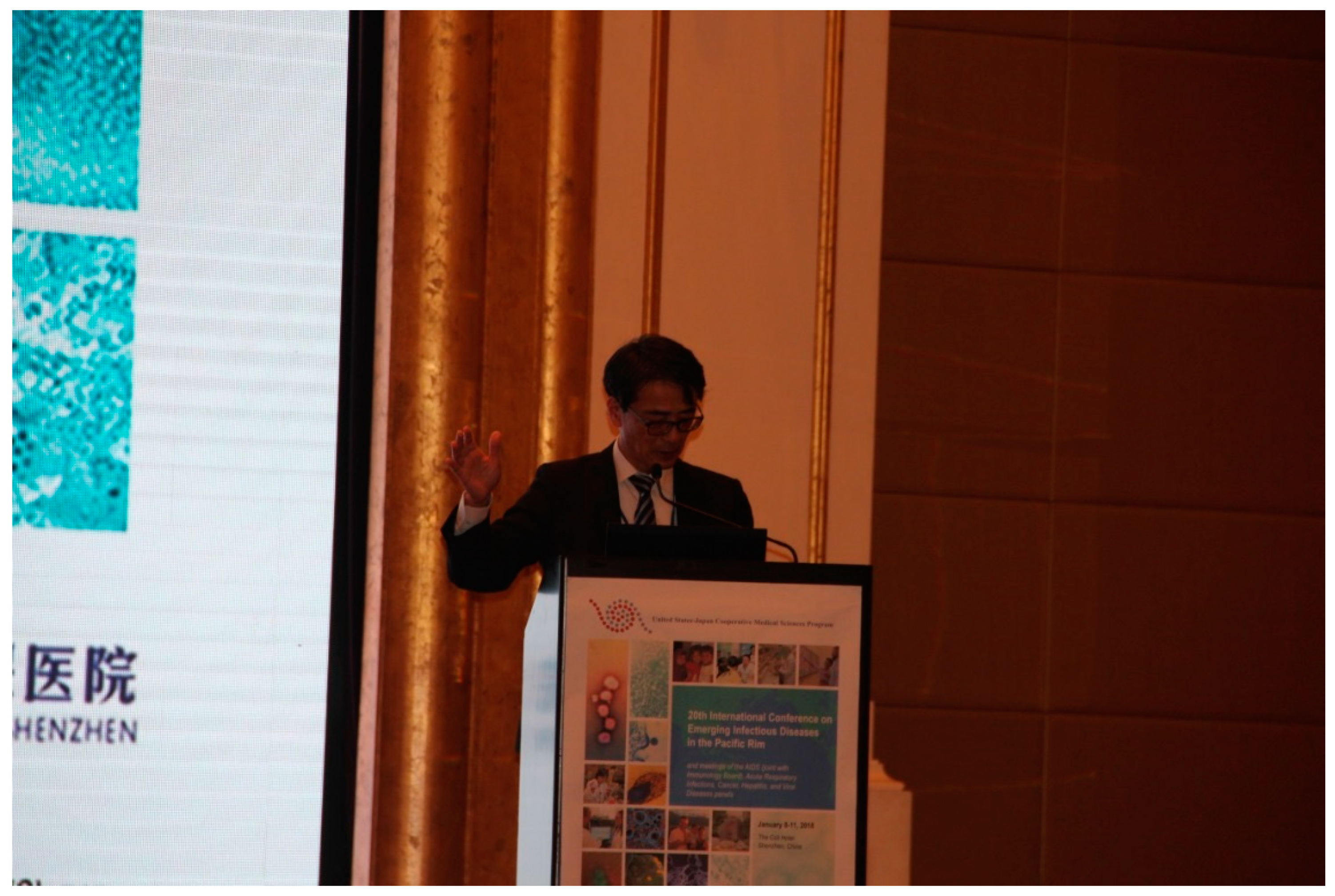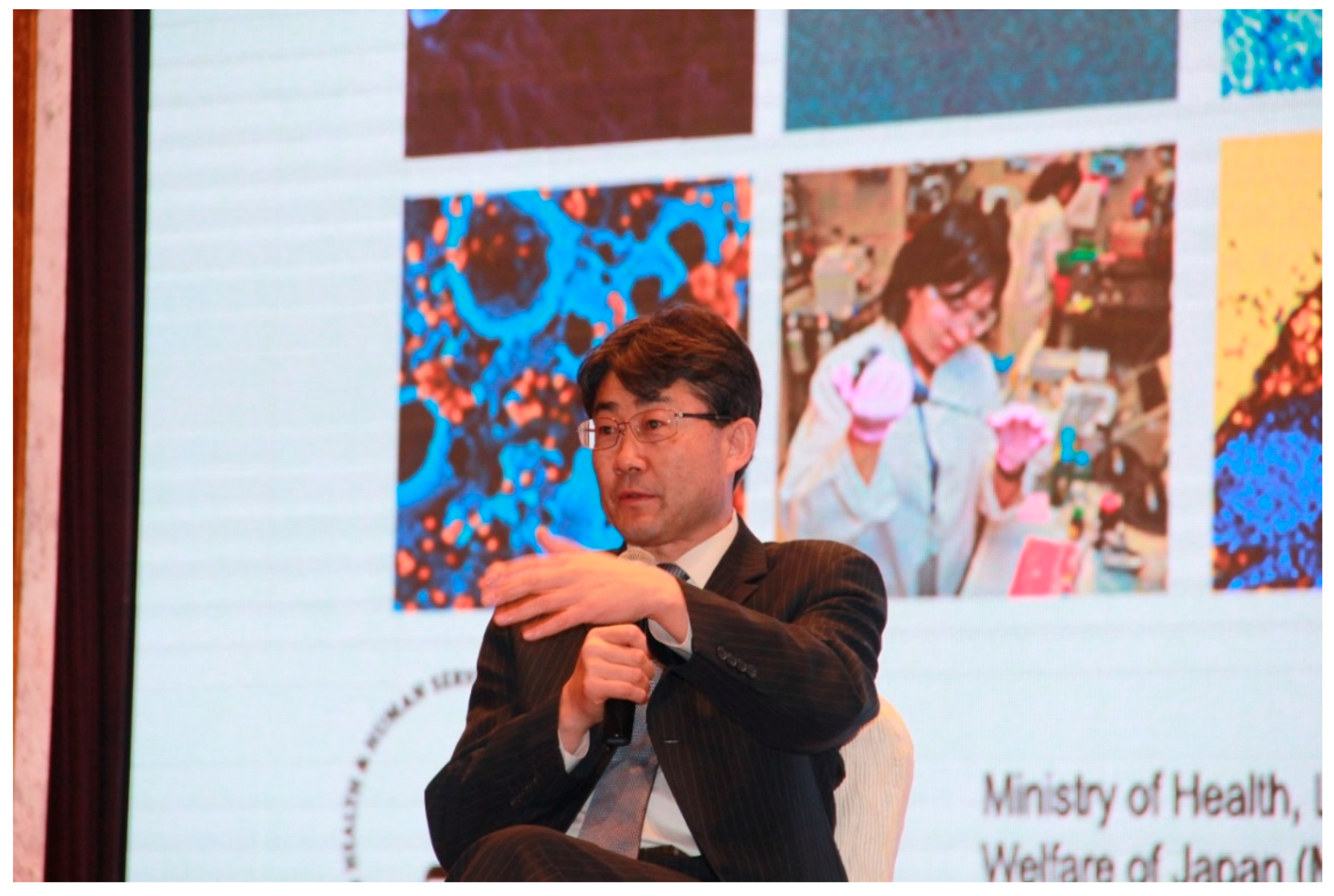20th International Conference on Emerging Infectious Diseases in the Pacific Rim Organized by the United States-Japan Cooperative Medical Sciences Program (USJCMSP)
Abstract
:1. Introduction
2. 2018 EID Conference
- a)
- La Montagne-Heilman Lectureship—Dr. Mary K. Estes (Baylor College of Medicine, U.S.A.) presented a talk entitled “Translating stem cell biology to understand gastrointestinal virus infection” (Figure 1). She discussed the utilization of human intestinal enteroid (HIE) cultures as pre-clinical models to study the response of the intestinal epithelium to human gastrointestinal infections, such as rotavirus and norovirus. HIEs could lead to a better understanding of human host-pathogen interactions, including innate immune responses, and potentially to identifying and testing new drug therapies for the prevention and treatment of diarrheal diseases.
- b)
- Shimao-Takeda Lectureship—Dr. Takaji Wakita (National Institute of Infectious Diseases, Japan) presented a talk, “Optimization of hepatitis C virus treatment and post-SVR syndrome” (Figure 2). Dr. Wakita discussed the development of a method that combines cell culture data with a mathematical model and computer simulation to quantify the anti-hepatitis C virus (HCV) efficacy of different drug concentrations and combinations in a preclinical setting. He reported that HCV treatment with direct-acting antivirals could achieve a sustained virologic response (SVR). However, a significant number of patients who achieve SVR developed hepatocellular carcinoma. Abnormal hepatocellular organelles in SVR patients indicate a persistent post-SVR syndrome.
2.1. Flash Talks from Recipients of the 2016 USJCMSP Collaborative Awards
2.2. Plenary Sessions
2.2.1. Session 1
- Avian influenza: The first presentation focused on the threat of avian influenza A H7N9 virus, which currently causes zoonotic infections that are mostly acquired in live bird markets. One rest day (closure) in poultry markets has a significant impact in reducing virus persistence and transmission of the virus through aerosols in poultry handling and de-feathering areas. The reported cases of H7N9 influenza underestimates the extent of human infection, and the effect of vaccination needs to be further studied.
- Hepatitis: Another talk reported on the endemic prevalence of hepatitis viruses in Mongolia, which has the highest rate of liver cancer mortality in the world that is about 12 times the global average. The high prevalence is mostly health-system driven, with the use of dirty needles and improper sterilization of dental equipment, but injection drug abuse also contributes. Sixty percent of hepatitis B virus (HBV)-infected Mongols are co-infected with hepatitis delta virus (HDV). The government of Mongolia adopted a plan that includes screening every citizen for hepatitis virus infection to prevent, control, and eventually eliminate hepatitis in Mongolia.
- Dengue: An overview of dengue, a public health priority in the region, was presented. The distribution of dengue is widespread and inflicts a high medical and cost burden. The pathogenesis of dengue virus infection remains unclear, and there are pitfalls in diagnosis and management of the disease. There has been a shift in the epidemiology, with infections and disease moving to rural areas.
- Zika: A presentation of the current state of Zika virus (ZIKV) epidemiology was provided. ZIKV is amplified much more frequently than other viruses through Aedes aegypti and Aedes albopictus mosquitos. Particularly in Africa, strains were seen to be transmitted much more efficiently by Aedes aegypti and there is no evidence that primates are intermediates of transmission. Several different topics were discussed about ZIKV including the association between ZIKV infection and microcephaly and Guillain-Barre syndrome, when and how ZIKV arrived in the Americas, and whether chikungunya and dengue virus infections can provide insight into ZIKV infection in the Americas. Several studies have failed to provide evidence of immune enhancement, although the question remains if dengue virus immunity affects ZIKV infection or vice versa. The evolution of urban transmission was also considered, with the emergence of different virus strains.
- Crimean–Congo hemorrhagic fever (CCHF): The expansion of CCHF to Asia was reviewed. CCHFV is an orthonairovirus transmitted by the bite of the tick, Hyalomma marginatum. The incubation period of the infection is 2–7 days, and death occurs in 7–9 days. The re-assortment of genes among the CCHF viruses can lead to new strains and new diseases, with many countries reporting increased numbers of cases. This may be due to more infected ticks, amplification, migratory birds, or the live animal trade. Increased tick activity has been observed during the Eid festival, which coincides with backyard slaughter of animals, and an increase in human infection.
2.2.2. Session 2
- Hepatitis C: The first talk in this session compared the level of immune markers, such as PD-1 and CD91, before and after antiviral treatment for hepatitis C virus (HCV) infection and found that those levels were lower after treatment.
- Coronavirus: The next presentation shared how in coronaviruses, exoribonuclease (ExoN) plays a key role in maintaining a low mutational rate for the virus, and exon deletion increases the mutation rate as well as the attenuation of pathogenesis.
- Enterovirus 71 (EV71): Then a talk focused on the EV71 carrying VP1-145E variants, which are mainly responsible for the development of viremia and neuropathogenesis in a non-human primate model. This further suggested the involvement of amino acid polymorphism at VP1-145 in cell-specific viral replication, in vivo fitness, and pathogenesis in EV71-infected individuals.
- HIV-1: One talk presented that HIV-1 integrase (IN) is a key target of newly developed anti-retroviral drugs. High-resolution cryo-EM analysis demonstrated that IN assembles into a multimeric structure, up to 16 monomers in size, to form the intasome structure that mediates chromosomal integration. The resolution of the active site revealed the strand transfer inhibitor drug target, as well as potential new structural targets for next-generation IN inhibitors. Another talk reported that human leukocyte antigen (HLA)-B57 and HLA-B27 haplotypes are associated with the control of HIV-1 viremia and disease progression in Caucasian and African populations, but are poorly represented in people of Japanese descent. The research team found that HLA-B52:01 and HLA-C12:02, found in approximately 20% of Japanese individuals, is associated with significantly lower HIV-1 viral loads and increased CD4 cell counts. In addition, the natural killer (NK) cell receptor, killer cell immunoglobulin-like receptor (KIR) 2DL2, may also contribute to the control of HIV-1 in Japanese individuals, suggesting both cytotoxic T lymphocyte (CTL) and NK responses play an important role in controlling HIV disease progression.
- Reovirus: A talk featured the reovirus reverse genetic system, which was established by transfecting the cell via plasmids, each coding a segment of reovirus genome. This is a major development for the reovirus field.
- Hepatitis B (HBV): The host Na+-taurocholate cotransporting polypeptide (NTCP) protein, found to be an essential component for HBV infection in the liver, was discussed. The Ser267Phe (S267F) variant of NTCP is inversely associated with HBV pathogenesis and cirrhosis. The NTCP sequence is also a determinant for host range.
- Zika: A talk showed that dengue 2 antibody levels appear to determine susceptibility to ZIKV infection with high dengue 2 titers being protective, while lower titers enhance infection.
2.2.3. Session 3
2.2.4. Session 4
- Dengue: A description of the dengue vaccine target product profile and an overview of an experimental live-attenuated dengue vaccine developed primarily by National Institute of Allergy and Infectious Diseases (NIAID), which was found to be safe and protective in virus challenge studies, were provided. An ongoing Phase 3 clinical trial in Brazil was also discussed.
- Zika: An overview of a promising experimental single-dose live-attenuated Zika vaccine that was evaluated in non-human primates was presented. This was found to prevent infection and achieve protective immunity within 14 days post-vaccination.
- Respiratory syncytial virus (RSV) infection: The global disease burden of RSV and the need for more than one RSV vaccine to target different age populations were described. Also an overview of the RSV vaccines currently in clinical development: vaccine-like particle, live-attenuated, and vector-based vaccines, were further discussed.
- HIV/AIDS: A talk summarized the findings from a cohort study of individuals identified with acute HIV infection in Bangkok, Thailand.
- Influenza: A detailed description of a universal influenza virus vaccine strategy based on the conserved stalk domain of hemagglutinin was presented.
- Hand-foot-and-mouth disease (HFMD): The epidemiological baseline of HFMD caused by multiple serotypes of enterovirus in China and the implications for vaccine development were discussed.
- Chikungunya: A presentation described the versatility and advantages of a measles vector vaccine platform and the Phase 2 clinical safety and immunogenicity of a measles-vectored chikungunya vaccine.
2.2.5. Session 5
- Norovirus: A high-resolution structural analysis of viral proteins has provided a platform for a rational drug design for norovirus. With a better understanding of innate immunity, this could lead to new approaches for vaccine delivery. A new protein delivery system was also introduced, which may potentially become a component of a needleless vaccine candidate.
- ZIKV: The structural biology of ZIKV proteins suggests potential drug targets in the non-structural 1 (NS1) and non-structural 5 (NS5) viral proteins. The NS1 structure could provide information on host interaction and protective antibody recognition, as well as potential drug target sites. Structural analysis needs to be confirmed with functional data to demonstrate further if drug candidates, such as those against dengue virus, would be effective for ZIKV infection.
3. Panel/Board Meetings
3.1. AIDS Panel and Immunology Board
3.2. Acute Respiratory Infections (ARI) Panel
3.3. Cancer Panel
3.4. Hepatitis Panel
3.5. Viral Diseases Panel
4. Conclusions and Future Perspective
Author Contributions
Funding
Acknowledgments
Conflicts of Interest
References
- Organization and History of the U.S.-Japan Cooperative Medical Sciences Program. Available online: https://1997-2001.state.gov/global/oes/health/usjcmsp.html (accessed on 18 March 2019).
- Brennan, P.J. 50 Years On: The United States-Japan Cooperative Medical Science Program 1965–2015 (Part II): The Leprosy Joint Panel. Nihon Hansenbyo Gakkai Zasshi 2015, 84, 79–86. [Google Scholar] [CrossRef] [PubMed]
- Brennan, P.J. 50 Years On: The United States-Japan Cooperative Medical Science Program 1965–2015 (Part I). Nihon Hansenbyo Gakkai Zasshi 2014, 83, 63–68. [Google Scholar] [CrossRef] [PubMed]
- Conference on Emerging Diseases. Proceedings. The United States-Japan Cooperative Medical Sciences Program. Tokyo. FEMS Immunol. Med. Microbiol. 1997, 18, 219–341. [Google Scholar]
- Umenai, T.; Narula, M.; Onuki, D.; Yamamoto, T.; Igari, T. International HIV and AIDS prevention: Japan/United States collaboration. J. Acquir. Immune Defic. Syndr. Hum. Retrovirol. 1997, 14, S58–S67. [Google Scholar] [CrossRef] [PubMed]
- Carpenter, C.C. Cholera research: United States-Japan cooperative medical science program. Science 1968, 159, 1262. [Google Scholar] [CrossRef] [PubMed]
- Mori, T. MDR-TB-its characteristics and control in Asia-Pacific rim symposium in USJCMSP 10th international conference on emerging infectious diseases in the Pacific rim. Tuberculosis 2007, 87, S5–S9. [Google Scholar] [CrossRef] [PubMed]
- Dixon, D.M. US-Japan workshops in medical mycology: past, present and future. Nihon Ishinkin Gakkai Zasshi 2001, 42, 75–80. [Google Scholar] [CrossRef] [PubMed]



| Date | City/Country | Topics | Local Chairs | |
|---|---|---|---|---|
| 1st | July 27–28, 1996 | Kyoto, Japan | General Review | Tadao Shimao |
| 2nd | March 6–8, 1997 | Bangkok, Thailand | Enteric Infections Viral Infections | Wanpen Chaicumpa |
| 3rd | March 28–30, 1998 | Bali, Indonesia | Malaria, Tuberculosis, Hepatitis Infection and Malignancy | Pratiwi Sodermono |
| 4th | March 2–4, 1999 | Bangkok, Thailand | Parasitic Infections Influenza | Wanpen Chaicumpa |
| 5th | January 7–9, 2000 | Chennai, India | Tuberculosis and Leprosy HIV/AIDS | N.K. Ganguly |
| 6th | January 13–15, 2001 | Manila, Philippines | Bacterial Diarrheal Diseases Viral Zoonotic Diseases | Benjamin C. Vitasa Mario R. Festin |
| 7th | October 31–November 1, 2002 | Shanghai, China | Acute Respiratory Infections Parasitic Zoonoses | Linhua Tang Yumei Wen Zheng Feng |
| 8th | December 11–12, 2003 | Dhaka, Bangladesh | HIV/AIDS & Cholera and other Bacterial Enteric Infections | A.F.M. Sarwar Kamal |
| 9th | December 10, 2004 | Kyoto, Japan | Influenza | Yoshifumi Takeda |
| 10th | November 16–17, 2005 | Hanoi, Vietnam | HIV/AIDS and Tuberculosis | Nguyen Tran Hien |
| 11th | November 16–18, 2006 | Singapore | Avian Influenza | Chee Yam Cheng |
| 12th | December 4–6, 2007 | Haikou, China | Antimicrobial Resistance in Respiratory Infections | Yichen Lu |
| 13th | April 6–9, 2009 | Kolkata, India | Enteric Diseases | G. Balakrish Nair |
| 14th | October 4–6, 2010 | Penang, Malaysia | Diagnostics for Infectious Diseases | Asma Ismail, Rusli Ismail, M. Ravichandran |
| 15th | March 11–13, 2013 | Singapore | Vaccines and Protective Immunity (Viral Diseases) | Richard James Coker |
| 16th | February 9–13, 2014 | Dhaka, Bangladesh | Antimicrobial Drug Resistance in Bacterial and Parasitic Diseases | John D. Clemens |
| 17th | January 26–27, 2015 | Taipei, Taiwan | Emerging Viral Infectious Diseases | Chien-Jen Chen |
| 18th | January 11–12, 2016 | Bethesda, MD U.S.A. | Research Technologies/Innovations | NIH |
| 19th | February 7–8, 2017 | Seoul, South Korea | AMR of Bacterial and Parasitic Diseases | Jerome Kim |
| 20th | January 8–9, 2018 | Shenzhen, China | Pathogenesis and Protective Immunity of Viral Diseases | George Fu Gao |
| 21st | February 26–March 1, 2019 | Hanoi, Vietnam | Bacterial and Parasitic Diseases | Ministry of Health of Vietnam |
| 22nd | February 2020 | To be confirmed | Viral Diseases |
© 2019 by the authors. Licensee MDPI, Basel, Switzerland. This article is an open access article distributed under the terms and conditions of the Creative Commons Attribution (CC BY) license (http://creativecommons.org/licenses/by/4.0/).
Share and Cite
USJCMSP AIDS, ARI, Cancer, Hepatitis, Immunology and Viral Diseases Panels; Bernabe, K.G.; Lu, K.T.; Handley, F.G.; Griffin, D.E.; Kurane, I.; Iwamoto, A.; Gao, G.F.; Krammer, F. 20th International Conference on Emerging Infectious Diseases in the Pacific Rim Organized by the United States-Japan Cooperative Medical Sciences Program (USJCMSP). Vaccines 2019, 7, 35. https://doi.org/10.3390/vaccines7020035
USJCMSP AIDS, ARI, Cancer, Hepatitis, Immunology and Viral Diseases Panels, Bernabe KG, Lu KT, Handley FG, Griffin DE, Kurane I, Iwamoto A, Gao GF, Krammer F. 20th International Conference on Emerging Infectious Diseases in the Pacific Rim Organized by the United States-Japan Cooperative Medical Sciences Program (USJCMSP). Vaccines. 2019; 7(2):35. https://doi.org/10.3390/vaccines7020035
Chicago/Turabian StyleUSJCMSP AIDS, ARI, Cancer, Hepatitis, Immunology and Viral Diseases Panels, K. Gayle Bernabe, Kristina T. Lu, F. Gray Handley, Diane E. Griffin, Ichiro Kurane, Aikichi Iwamoto, George F. Gao, and Florian Krammer. 2019. "20th International Conference on Emerging Infectious Diseases in the Pacific Rim Organized by the United States-Japan Cooperative Medical Sciences Program (USJCMSP)" Vaccines 7, no. 2: 35. https://doi.org/10.3390/vaccines7020035
APA StyleUSJCMSP AIDS, ARI, Cancer, Hepatitis, Immunology and Viral Diseases Panels, Bernabe, K. G., Lu, K. T., Handley, F. G., Griffin, D. E., Kurane, I., Iwamoto, A., Gao, G. F., & Krammer, F. (2019). 20th International Conference on Emerging Infectious Diseases in the Pacific Rim Organized by the United States-Japan Cooperative Medical Sciences Program (USJCMSP). Vaccines, 7(2), 35. https://doi.org/10.3390/vaccines7020035






